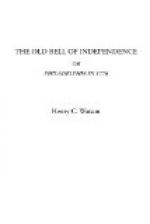“There is considerable dispute in regard to the circumstances attending the massacre. It seems impossible to get at the precise truth,” observed Mrs. Harmar. “It’s my opinion, the horrors of the event have been greatly exaggerated,” added Smith.
“I do not think they could be exaggerated,” replied Morton. “If you desire it, I will relate the circumstances as they were narrated to me. I can vouch for the strict regard to truth that has ever distinguished my friend.”
Of course, the company signified their desire to hear the account, and thereupon Morton began as follows.
“Wyoming, besides being a frontier settlement during the course of the Revolutionary war, and therefore constantly exposed to the inroads of the savages, had furnished two full companies, and about sixty recruits more, for the main army—all which were annexed to the Connecticut line, and armed at their own expense. They amounted, in the whole, to two hundred and thirty men. While thus weakened and unguarded, they were invaded by an army from Niagara, in the British service, composed of regulars, tories, and Indians; of which the Indians composed the greater part.
“The Indians, in the spring of 1777, began to be troublesome. Their numbers were frequently augmented by the arrival of new parties; and it was from the cattle, hogs, and other plunder taken from the inhabitants, that they furnished themselves with provisions. Some of the inhabitants were killed by them, and others captured; and they destroyed much property. At length they became very formidable.
“The inhabitants had erected several small forts, but the principal one was Forty Fort, in Kingston, on the west side of the river, a small distance above Wyoming Falls. To this the settlers had chiefly resorted. They had sent agents to the continental army to acquaint them with their distressed situation; in consequence of which, Captain Spaulding, with about sixty or seventy men, was dispatched to their assistance. This detachment was, at the time of the massacre, about forty miles distant. The garrison had been apprised of their march from Lancaster, but not of their proximity.
“The people in the garrison grew uneasy, under the insults of the invaders. The militia were placed under officers taken from themselves, and the whole body was commanded by Colonel Zebulon Butler, of the continental army. Colonel Dennison, of the militia, was second in command. There was a fortification about three miles above Forty Fort, called Wintermoot’s Fort. This was in the possession of tories. They surrendered at the approach of the enemy, without opposition, and gave them aid; some of them entering fully into their interests. Wintermoot’s Fort instantly became the headquarters of the expedition from Canada; and was commanded by Colonel John Butler, a British officer, and commander of a party of rangers. The second in command was Colonel Brandt, a natural son of Sir William Johnson,




